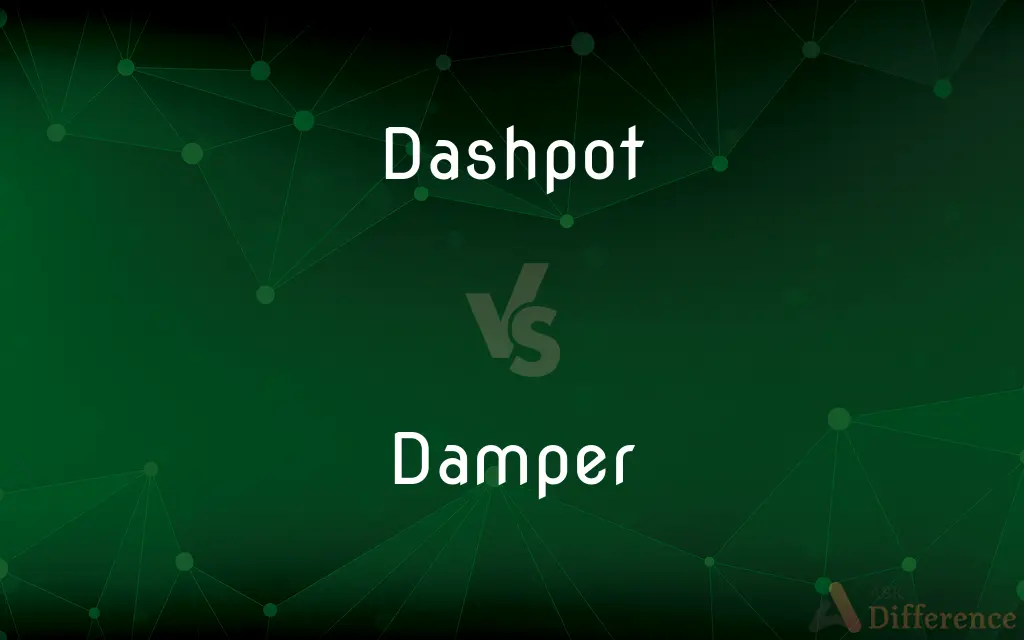Dashpot vs. Damper — What's the Difference?
By Tayyaba Rehman & Urooj Arif — Updated on April 2, 2024
A dashpot is a mechanical device using fluid resistance to damp vibrations, typically linear motion, whereas a damper controls vibrations across various mechanisms, not limited to fluid resistance.

Difference Between Dashpot and Damper
Table of Contents
ADVERTISEMENT
Key Differences
Dashpots utilize fluid (oil or air) to provide resistance against motion, effectively slowing down linear movements to mitigate vibrations and shocks. This principle is particularly useful in applications where controlled, slow motion is required, such as in door closers or shock absorbers. On the other hand, dampers encompass a broader range of devices designed to dampen vibrations, noise, or oscillations in mechanical systems, including but not limited to fluid-based solutions. Dampers can be mechanical, hydraulic, or even electrical, offering versatile applications from buildings to automotive systems.
While dashpots specifically work through the displacement of fluid to create a damping effect, dampers can utilize various mechanisms, such as friction, to achieve their goal. Whereas dashpots are primarily designed for linear damping applications, dampers can be tailored for both linear and rotational systems, making them applicable in a wider array of scenarios.
The design of a dashpot is typically straightforward, focusing on the fluid dynamics inside a cylinder to achieve damping. In contrast, dampers can vary significantly in design and complexity, from simple rubber mounts to sophisticated active control systems. This diversity allows dampers to be customized for specific needs and environments, providing targeted solutions for vibration control.
Dashpots are commonly found in applications where precise control over speed and motion is necessary, acting as a predictable and reliable method for slowing down mechanical components. Dampers, however, are integral to maintaining the integrity and performance of a broader range of systems, from reducing structural vibrations in buildings to enhancing the comfort and stability of vehicles.
Despite their differences, both dashpots and dampers play crucial roles in protecting components and structures from the adverse effects of vibrations, shocks, and oscillations. Their selection and application depend on the specific requirements of the system, including the type of motion, desired level of damping, and environmental considerations.
ADVERTISEMENT
Comparison Chart
Principle of Operation
Utilizes fluid resistance to slow down motion
Can use fluid, friction, or electrical resistance
Application
Primarily linear motion
Linear and rotational systems
Mechanism
Fluid displacement in a cylinder
Various, including mechanical, hydraulic, electrical
Design Complexity
Generally straightforward
Ranges from simple to highly complex
Typical Uses
Door closers, shock absorbers
Buildings, vehicles, industrial machinery
Compare with Definitions
Dashpot
A device using fluid to damp linear motion.
The dashpot in a screen door ensures it closes gently.
Damper
A device to control vibrations, noise, or oscillations.
The damper in a building's structure reduces sway during windstorms.
Dashpot
Primarily focuses on damping vibrations.
Dashpots in electronic components protect against shock damage.
Damper
Can be mechanical, hydraulic, or electrical.
An electrical damper adjusts to varying loads for better control.
Dashpot
Employs oil or air for resistance.
An oil-filled dashpot is used for smoother operation in heavy machinery.
Damper
Suitable for a wide range of applications.
Automotive dampers improve ride quality by reducing road noise and vibrations.
Dashpot
Relies on fluid dynamics for operation.
Engineers calculate the fluid viscosity needed in a dashpot for optimal performance.
Damper
Essential for maintaining system integrity.
Industrial machines use dampers to prolong their operational life and efficiency.
Dashpot
Designed for controlled, slow movement.
Precision equipment uses dashpots to prevent abrupt movements.
Damper
Varied in design based on application needs.
A friction damper is used in some engines to minimize noise.
Dashpot
A dashpot, also known as a damper, is a mechanical device that resists motion via viscous friction. The resulting force is proportional to the velocity, but acts in the opposite direction, slowing the motion and absorbing energy.
Damper
One that deadens, restrains, or depresses
Rain put a damper on our picnic plans.
Dashpot
A device consisting of a piston that moves within a cylinder containing oil, used to dampen and control motion.
Damper
An adjustable plate, as in the flue of a furnace or stove, for controlling the draft.
Dashpot
A mechanical damping device consisting of a piston that moves through a viscous fluid (usually oil); used, in conjunction with a spring, in shock absorbers.
Damper
A device in various keyboard instruments for deadening the vibrations of the strings.
Dashpot
A mechanical damping device containing a piston that moves in a fluid-filled chamber to serve as a pneumatic or hydraulic cushion for a falling weight, as in the valve gear of a steam engine, to prevent shock.
Damper
A mute for various brass instruments.
Damper
A device that eliminates or diminishes vibrations or oscillations, as of a magnetic needle.
Damper
Something that damps or checks:
Damper
A valve or movable plate in the flue or other part of a stove, furnace, etc., used to check or regulate the draught of air.
Damper
A contrivance (sordine), as in a pianoforte, to deaden vibrations; or, as in other pieces of mechanism, to check some action at a particular time.
Damper
Something that kills the mood.
Damper
A device that decreases the oscillations of a system.
Damper
(mechanical engineering) A shock absorber.
Damper
Bread made from a basic recipe of flour, water, milk, and salt, but without yeast.
Damper
That which damps or checks;
Nor did Sabrina's presence seem to act as any damper at the modest little festivities.
Damper
A movable iron plate that regulates the draft in a stove or chimney or furnace
Damper
A device that decreases the amplitude of electronic, mechanical, acoustical, or aerodynamic oscillations
Damper
A depressing restraint;
Rain put a damper on our picnic plans
Common Curiosities
Where are dashpots commonly used?
Dashpots are found in applications requiring controlled, slow motion, such as in door closers, precision equipment, and shock absorbers.
How does a damper work?
A damper reduces vibrations, noise, or oscillations in mechanical systems through various means, including fluid resistance, friction, or electrical mechanisms, depending on the design.
How do dampers contribute to vehicle safety?
Dampers in vehicles reduce vibrations and oscillations, improving ride quality, handling, and stability, thereby contributing to overall safety.
What is a dashpot?
A dashpot is a mechanical device that uses fluid resistance, such as oil or air, to dampen linear motion and vibrations in machinery and equipment.
Can dampers be used in rotating systems?
Yes, dampers are designed for both linear and rotational systems, making them versatile in applications ranging from vehicles to industrial machinery.
Can dampers be adjusted for different conditions?
Some dampers, especially in industrial and automotive applications, are adjustable to accommodate varying loads, speeds, and environmental conditions for optimal performance.
What makes dampers different from dashpots?
Dampers encompass a broader range of devices and mechanisms for controlling vibrations, not limited to fluid resistance, and can be tailored for various applications, unlike dashpots which specifically use fluid dynamics for damping.
What factors influence the choice between a dashpot and a damper?
Factors include the type of motion (linear vs. rotational), desired damping mechanism (fluid, friction, electrical), complexity, and specific application requirements.
What role do dampers play in building design?
Dampers are integral to modern building design, mitigating the effects of wind and seismic activity to ensure structural integrity and occupant comfort.
How do electrical dampers differ from hydraulic dampers?
Electrical dampers use electrical resistance and control mechanisms for damping, offering precise adjustability, whereas hydraulic dampers rely on fluid dynamics and are typically less adjustable.
Why are dashpots important in precision equipment?
Dashpots ensure that movements are controlled and gradual, preventing abrupt shocks that could damage sensitive components or disrupt accurate measurements.
What is the significance of fluid viscosity in a dashpot?
The viscosity of the fluid in a dashpot determines the resistance to motion, affecting the damping rate and performance.
Is a dashpot the same as a hydraulic damper?
While both may use fluid to dampen motion, a dashpot is a specific type of hydraulic damper designed for linear applications, emphasizing simplicity and predictability.
Can a dashpot be used in an electronic device?
Yes, dashpots are used in electronic devices to protect sensitive components from shocks and vibrations.
How do design engineers select dampers for machinery?
Engineers consider factors such as the type of vibrations, system dynamics, environmental conditions, and the specific damping needs of the machinery to select the most appropriate damper.
Share Your Discovery

Previous Comparison
Consolidated vs. Unconsolidated
Next Comparison
Trial vs. TestingAuthor Spotlight
Written by
Tayyaba RehmanTayyaba Rehman is a distinguished writer, currently serving as a primary contributor to askdifference.com. As a researcher in semantics and etymology, Tayyaba's passion for the complexity of languages and their distinctions has found a perfect home on the platform. Tayyaba delves into the intricacies of language, distinguishing between commonly confused words and phrases, thereby providing clarity for readers worldwide.
Co-written by
Urooj ArifUrooj is a skilled content writer at Ask Difference, known for her exceptional ability to simplify complex topics into engaging and informative content. With a passion for research and a flair for clear, concise writing, she consistently delivers articles that resonate with our diverse audience.
















































